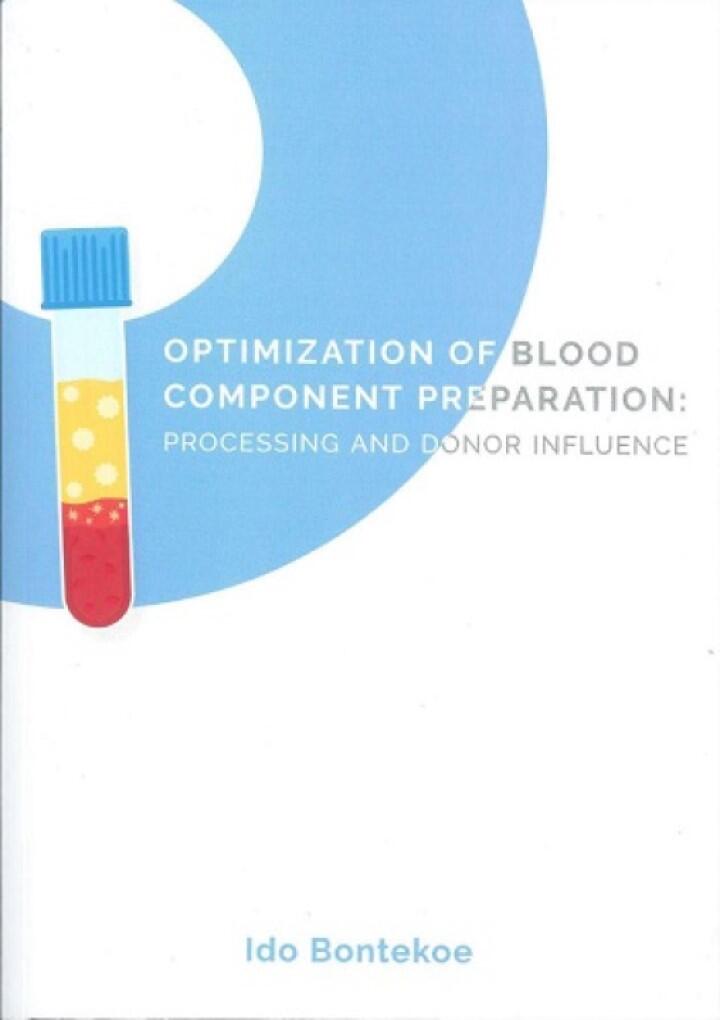Thesis Ido Bontekoe
On 12 June 2019 (13:00 hrs) Ido Bontekoe defended his PhD thesis 'Optimization of blood component preparation: Processing and donor influence'.
Promotor: Prof AJ Verhoeven PhD
Copromotores: D de Korte PhD and PF van der Meer PhD
Venue: Aula, University of Amsterdam
Summary

To improve the quality of blood products several processing steps were studied and optimized.
A new method for preparation of red cells, that has the potential to reduce donor exposure for fetuses in need of intrauterine transfusion (IUT) was developed. Because IUT of fetuses for treatment of hemolytic anemia is associated with additional antibody formation, red cells with the closest match between donor and mother are preferred. Finding such red cells from inventory is complicated and, moreover, a fetus needs a median of 3 IUTs. Collection of repeated low volume donations of 100 or 200 mL whole blood from one selected donor during the entire IUT treatment period would reduce donor exposition and possibly IUT-associated allo-immunization.
Furthermore, it was demonstrated in an older donor group that platelet storage performance is partly donor dependent. Based on QC data of outdated PCs, 6 donors with good and 6 with poor-storing PCs were selected. Donor characteristics were about comparable. Lactate production in ‘good’ PCs was lower than in ‘poor’ PCs resulting in a higher pH from Day 5 onwards. At the end of storage, the ‘good’ PCs were less activated, showed less signs of apoptosis, and had a higher mitochondrial membrane potential.
Nonetheless, also the ‘poor’ PCs fulfilled European Guidelines during 7 day storage. The differences were perhaps due to different functionality of the mitochondria, but this could not be proven. With regard to the donors, it was found that metabolic syndrome and Type 2 diabetes are likely causes for ‘poor’ platelet storage properties.
Further exploration of this finding that platelet storage properties are consistent by donor was performed by investigating PCs from young donors, as well as from older donors with and without Type 2 diabetes. Among the groups, all PCs had comparable composition, but after storage, PCs from young donors showed a higher pH than PCs from older donors, due to a lower lactate production. Also, CD62P expression and hypotonic shock response reflected better in vitro quality, so platelets from young donors exhibited the best storage conditions.
In the older groups, no association with Type 2 diabetes was found. On the cellular level, also no differences in mitochondrial membrane potential were detected between any of the groups. On average, platelets from older donors showed poorer in vitro quality but, considering the storage conditions used in this study, the implications for the daily blood bank routine is probably small. Recently, the Dutch blood bank switched to PAS-E as universal storage medium for platelets, which was not only a step forward in standardization, but may also mitigate effects of poor-storing platelets. To establish the underlying causes of poor storage performance and the implications for donors and blood products, more research is needed.
Chapters
Chapter I
General introduction
Part I: Whole blood processing and red blood cell concentrates
Chapter 2
Separation of centrifuged whole blood and pooled buffy coats using the new CompoMat G5: 3 years experience Abstract
Chapter 3
Critical re-appraisal of blood component quality after overnight hold of whole blood outside current room temperature limits Abstract
Chapter 4
Effect of rate and delay of cooling during initial cooling process: in vitro effect on red cells Abstract
Chapter 5
A new preparation method for red blood cells for intrauterine transfusion enabling reduction of donor exposure Abstract
Part II: Thromboelastography and donor-related platelet storage performance
Chapter 6
Thromboelastography as a tool to evaluate blood component quality: a review
Chapter 7
Determination of thromboelastographic responsiveness in stored single-donor platelet concentrates Abstract
Chapter 8
Platelet storage performance is consistent by donor: a pilot study comparing "good" and 'poor storing platelets Abstract
Chapter 9
Donor age is associated with platelet storage properties: in vitro quality of platelets from young donors and aged donors with and without Type 2 Diabetes Abstract
Chapter 10
Future prospects